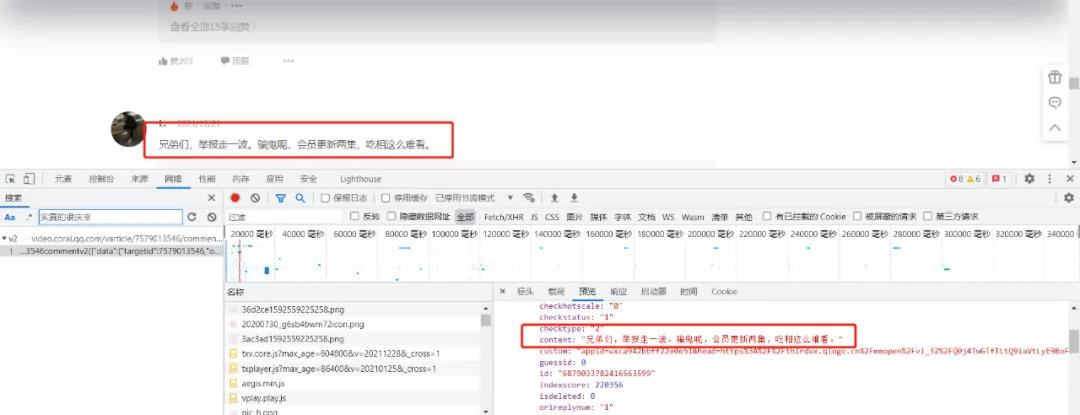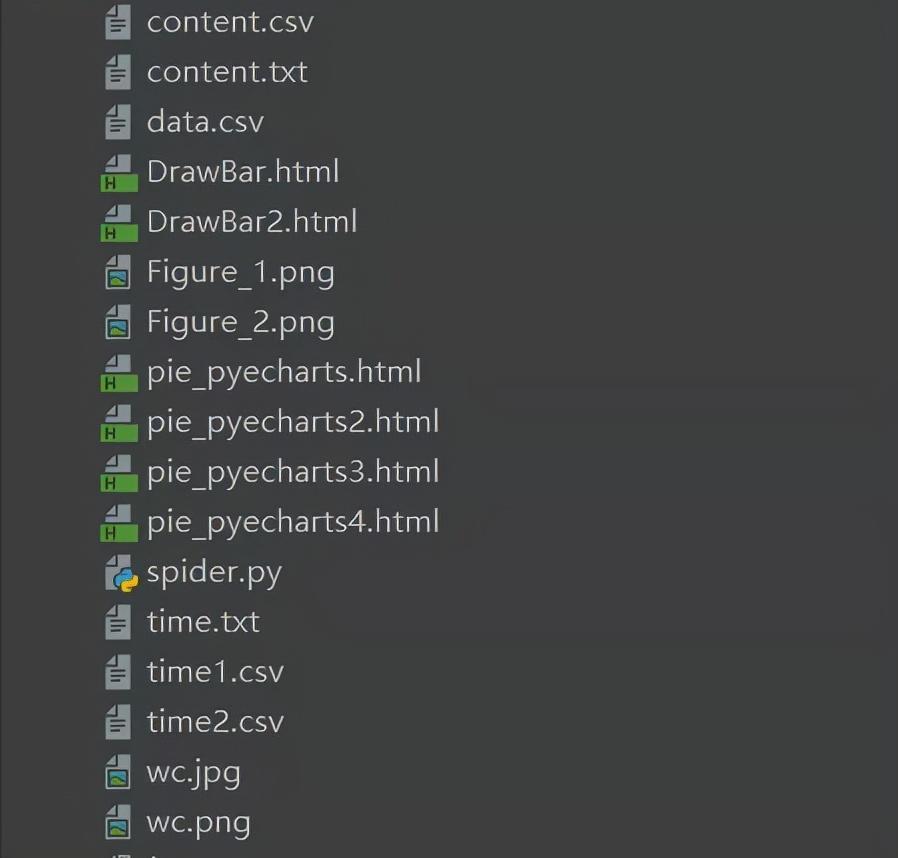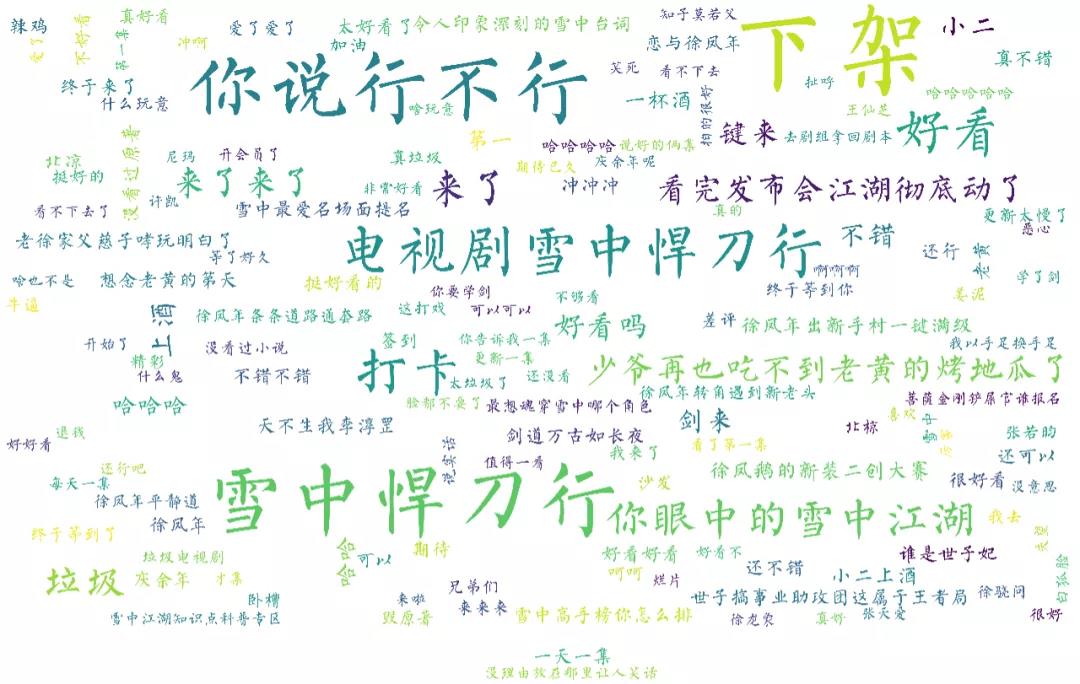用 Python 爬取了《雪中悍刀行》数据,终于知道它为什么这么火了
Posted Leo.yuan
tags:
篇首语:本文由小常识网(cha138.com)小编为大家整理,主要介绍了用 Python 爬取了《雪中悍刀行》数据,终于知道它为什么这么火了相关的知识,希望对你有一定的参考价值。
转载来源/志斌的python笔记
绪论
大家好,我是J哥。

本期是对腾讯热播剧——雪中悍刀行的一次爬虫与数据分析,耗时一个小时,总爬取条数1W条评论,很适合新人练手。

爬虫方面:由于腾讯的评论数据是封装在json里面,所以只需要找到json文件,对需要的数据进行提取保存即可。

视频网址:https://v.qq.com/x/cover/mzc0020020cyvqh.html
评论json数据网址:https://video.coral.qq.com/varticle/7579013546/comment/v2
注:只要替换视频数字id的值,即可爬取其他视频的评论
如何查找视频id?


项目结构:

一. 爬虫部分:
1.爬取评论内容代码:spiders.py
import requests
import re
import random
def get_html(url, params):
uapools = [
‘Mozilla/5.0 (Macintosh; Intel Mac OS X 10_9_2) AppleWebKit/537.36 (KHTML, like Gecko) Chrome/35.0.1916.153 Safari/537.36’,
‘Mozilla/5.0 (Windows NT 6.1; WOW64; rv:30.0) Gecko/20100101 Firefox/30.0’,
‘Mozilla/5.0 (Macintosh; Intel Mac OS X 10_9_2) AppleWebKit/537.75.14 (KHTML, like Gecko) Version/7.0.3 Safari/537.75.14’
]
thisua = random.choice(uapools)
headers = "User-Agent": thisua
r = requests.get(url, headers=headers, params=params)
r.raise_for_status()
r.encoding = r.apparent_encoding
r.encoding = 'utf-8' # 不加此句出现乱码
return r.text
def parse_page(infolist, data):
commentpat = ‘“content”:"(.?)"’
lastpat = '“last”:"(.?)"’
commentall = re.compile(commentpat, re.S).findall(data)
next_cid = re.compile(lastpat).findall(data)[0]
infolist.append(commentall)
return next_cid
def print_comment_list(infolist):
j = 0
for page in infolist:
print(‘第’ + str(j + 1) + ‘页\\n’)
commentall = page
for i in range(0, len(commentall)):
print(commentall[i] + ‘\\n’)
j += 1
def save_to_txt(infolist, path):
fw = open(path, ‘w+’, encoding=‘utf-8’)
j = 0
for page in infolist:
#fw.write(‘第’ + str(j + 1) + ‘页\\n’)
commentall = page
for i in range(0, len(commentall)):
fw.write(commentall[i] + ‘\\n’)
j += 1
fw.close()
def main():
infolist = []
vid = ‘7579013546’;
cid = “0”;
page_num = 3000
url = ‘https://video.coral.qq.com/varticle/’ + vid + ‘/comment/v2’
#print(url)
for i in range(page_num):
params = 'orinum': '10', 'cursor': cid
html = get_html(url, params)
cid = parse_page(infolist, html)
print_comment_list(infolist)
save_to_txt(infolist, 'content.txt')
main()
2.爬取评论时间代码:sp.py
import requests
import re
import random
def get_html(url, params):
uapools = [
‘Mozilla/5.0 (Macintosh; Intel Mac OS X 10_9_2) AppleWebKit/537.36 (KHTML, like Gecko) Chrome/35.0.1916.153 Safari/537.36’,
‘Mozilla/5.0 (Windows NT 6.1; WOW64; rv:30.0) Gecko/20100101 Firefox/30.0’,
‘Mozilla/5.0 (Macintosh; Intel Mac OS X 10_9_2) AppleWebKit/537.75.14 (KHTML, like Gecko) Version/7.0.3 Safari/537.75.14’
]
thisua = random.choice(uapools)
headers = "User-Agent": thisua
r = requests.get(url, headers=headers, params=params)
r.raise_for_status()
r.encoding = r.apparent_encoding
r.encoding = 'utf-8' # 不加此句出现乱码
return r.text
def parse_page(infolist, data):
commentpat = ‘“time”:"(.?)"’
lastpat = '“last”:"(.?)"’
commentall = re.compile(commentpat, re.S).findall(data)
next_cid = re.compile(lastpat).findall(data)[0]
infolist.append(commentall)
return next_cid
def print_comment_list(infolist):
j = 0
for page in infolist:
print(‘第’ + str(j + 1) + ‘页\\n’)
commentall = page
for i in range(0, len(commentall)):
print(commentall[i] + ‘\\n’)
j += 1
def save_to_txt(infolist, path):
fw = open(path, ‘w+’, encoding=‘utf-8’)
j = 0
for page in infolist:
#fw.write(‘第’ + str(j + 1) + ‘页\\n’)
commentall = page
for i in range(0, len(commentall)):
fw.write(commentall[i] + ‘\\n’)
j += 1
fw.close()
def main():
infolist = []
vid = ‘7579013546’;
cid = “0”;
page_num =3000
url = ‘https://video.coral.qq.com/varticle/’ + vid + ‘/comment/v2’
#print(url)
for i in range(page_num):
params = 'orinum': '10', 'cursor': cid
html = get_html(url, params)
cid = parse_page(infolist, html)
print_comment_list(infolist)
save_to_txt(infolist, 'time.txt')
main()
二.数据处理部分
1.评论的时间戳转换为正常时间 time.py
coding=gbk
import csv
import time
csvFile = open(“data.csv”,‘w’,newline=’’,encoding=‘utf-8’)
writer = csv.writer(csvFile)
csvRow = []
#print(csvRow)
f = open(“time.txt”,‘r’,encoding=‘utf-8’)
for line in f:
csvRow = int(line)
#print(csvRow)
timeArray = time.localtime(csvRow)
csvRow = time.strftime("%Y-%m-%d %H:%M:%S", timeArray)
print(csvRow)
csvRow = csvRow.split()
writer.writerow(csvRow)
f.close()
csvFile.close()
2.评论内容读入csv CD.py
coding=gbk
import csv
csvFile = open(“content.csv”,‘w’,newline=’’,encoding=‘utf-8’)
writer = csv.writer(csvFile)
csvRow = []
f = open(“content.txt”,‘r’,encoding=‘utf-8’)
for line in f:
csvRow = line.split()
writer.writerow(csvRow)
f.close()
csvFile.close()
3.统计一天各个时间段内的评论数 py.py
coding=gbk
import csv
from pyecharts import options as opts
from sympy.combinatorics import Subset
from wordcloud import WordCloud
with open(’…/Spiders/data.csv’) as csvfile:
reader = csv.reader(csvfile)
data1 = [str(row[1])[0:2] for row in reader]
print(data1)
print(type(data1))
#先变成集合得到seq中的所有元素,避免重复遍历
set_seq = set(data1)
rst = []
for item in set_seq:
rst.append((item,data1.count(item))) #添加元素及出现个数
rst.sort()
print(type(rst))
print(rst)
with open(“time2.csv”, “w+”, newline=’’, encoding=‘utf-8’) as f:
writer = csv.writer(f, delimiter=’,’)
for i in rst: # 对于每一行的,将这一行的每个元素分别写在对应的列中
writer.writerow(i)
with open(‘time2.csv’) as csvfile:
reader = csv.reader(csvfile)
x = [str(row[0]) for row in reader]
print(x)
with open(‘time2.csv’) as csvfile:
reader = csv.reader(csvfile)
y1 = [float(row[1]) for row in reader]
print(y1)
4.统计最近评论数 py1.py
coding=gbk
import csv
from pyecharts import options as opts
from sympy.combinatorics import Subset
from wordcloud import WordCloud
with open(’…/Spiders/data.csv’) as csvfile:
reader = csv.reader(csvfile)
data1 = [str(row[0]) for row in reader]
#print(data1)
print(type(data1))
#先变成集合得到seq中的所有元素,避免重复遍历
set_seq = set(data1)
rst = []
for item in set_seq:
rst.append((item,data1.count(item))) #添加元素及出现个数
rst.sort()
print(type(rst))
print(rst)
with open(“time1.csv”, “w+”, newline=’’, encoding=‘utf-8’) as f:
writer = csv.writer(f, delimiter=’,’)
for i in rst: # 对于每一行的,将这一行的每个元素分别写在对应的列中
writer.writerow(i)
with open(‘time1.csv’) as csvfile:
reader = csv.reader(csvfile)
x = [str(row[0]) for row in reader]
print(x)
with open(‘time1.csv’) as csvfile:
reader = csv.reader(csvfile)
y1 = [float(row[1]) for row in reader]
print(y1)
三. 数据分析
数据分析方面:涉及到了词云图,条形,折线,饼图,后三者是对评论时间与主演占比的分析,然而腾讯的评论时间是以时间戳的形式显示,所以要进行转换,再去统计出现次数,最后,新加了对评论内容的情感分析。
1.制作词云图
wc.py
import numpy as np
import re
import jieba
from wordcloud import WordCloud
from matplotlib import pyplot as plt
from PIL import Image
上面的包自己安装,不会的就百度
f = open(‘content.txt’, ‘r’, encoding=‘utf-8’) # 这是数据源,也就是想生成词云的数据
txt = f.read() # 读取文件
f.close() # 关闭文件,其实用with就好,但是懒得改了
如果是文章的话,需要用到jieba分词,分完之后也可以自己处理下再生成词云
newtxt = re.sub("[A-Za-z0-9!%[],\\。]", “”, txt)
print(newtxt)
words = jieba.lcut(newtxt)
img = Image.open(r’wc.jpg’) # 想要搞得形状
img_array = np.array(img)
相关配置,里面这个collocations配置可以避免重复
wordcloud = WordCloud(
background_color=“white”,
width=1080,
height=960,
font_path="…/文悦新青年.otf",
max_words=150,
scale=10,#清晰度
max_font_size=100,
mask=img_array,
collocations=False).generate(newtxt)
plt.imshow(wordcloud)
plt.axis(‘off’)
plt.show()
wordcloud.to_file(‘wc.png’)
轮廓图:wc.jpg

在这里插入图片描述
词云图:result.png (注:这里要把英文字母过滤掉)

2.制作最近评论数条形图 DrawBar.py
encoding: utf-8
import csv
import pyecharts.options as opts
from pyecharts.charts import Bar
from pyecharts.globals import ThemeType
class DrawBar(object):
"""绘制柱形图类"""
def __init__(self):
"""创建柱状图实例,并设置宽高和风格"""
self.bar = Bar(init_opts=opts.InitOpts(width='1500px', height='700px', theme=ThemeType.LIGHT))
def add_x(self):
"""为图形添加X轴数据"""
with open('time1.csv') as csvfile:
reader = csv.reader(csvfile)
x = [str(row[0]) for row in reader]
print(x)
self.bar.add_xaxis(
xaxis_data=x,
)
def add_y(self):
with open('time1.csv') as csvfile:
reader = csv.reader(csvfile)
y1 = [float(row[1]) for row in reader]
print(y1)
"""为图形添加Y轴数据,可添加多条"""
self.bar.add_yaxis( # 第一个Y轴数据
series_name="评论数", # Y轴数据名称
y_axis=y1, # Y轴数据
label_opts=opts.LabelOpts(is_show=True,color="black"), # 设置标签
bar_max_width='100px', # 设置柱子最大宽度
)
def set_global(self):
"""设置图形的全局属性"""
#self.bar(width=2000,height=1000)
self.bar.set_global_opts(
title_opts=opts.TitleOpts( # 设置标题
title='雪中悍刀行近日评论统计',title_textstyle_opts=opts.TextStyleOpts(font_size=35)
),
tooltip_opts=opts.TooltipOpts( # 提示框配置项(鼠标移到图形上时显示的东西)
is_show=True, # 是否显示提示框
trigger="axis", # 触发类型(axis坐标轴触发,鼠标移到时会有一条垂直于X轴的实线跟随鼠标移动,并显示提示信息)
axis_pointer_type="cross" # 指示器类型(cross将会生成两条分别垂直于X轴和Y轴的虚线,不启用trigger才会显示完全)
),
toolbox_opts=opts.ToolboxOpts(), # 工具箱配置项(什么都不填默认开启所有工具)
)
def draw(self):
"""绘制图形"""
self.add_x()
self.add_y()
self.set_global()
self.bar.render('../Html/DrawBar.html') # 将图绘制到 test.html 文件内,可在浏览器打开
def run(self):
"""执行函数"""
self.draw()
if name == ‘main’:
app = DrawBar()
app.run()
效果图:DrawBar.html

3.制作近日评论数饼图 pie_pyecharts.py
import csv
from pyecharts import options as opts
from pyecharts.charts import Pie
from random import randint
from pyecharts.globals import ThemeType
with open(‘time1.csv’) as csvfile:
reader = csv.reader(csvfile)
x = [str(row[0]) for row in reader]
print(x)
with open(‘time1.csv’) as csvfile:
reader = csv.reader(csvfile)
y1 = [float(row[1]) for row in reader]
print(y1)
num = y1
lab = x
(
Pie(init_opts=opts.InitOpts(width=‘1700px’,height=‘450px’,theme=ThemeType.LIGHT))#默认900,600
.set_global_opts(
title_opts=opts.TitleOpts(title=“雪中悍刀行近日评论统计”,
title_textstyle_opts=opts.TextStyleOpts(font_size=27)),legend_opts=opts.LegendOpts(
pos_top="10%", pos_left="1%",# 图例位置调整
),)
.add(series_name='',center=[280, 270], data_pair=[(j, i) for i, j in zip(num, lab)])#饼图
.add(series_name=’’,center=[845, 270],data_pair=[(j,i) for i,j in zip(num,lab)],radius=[‘40%’,‘75%’])#环图
.add(series_name=’’, center=[1380, 270],data_pair=[(j, i) for i, j in zip(num, lab)], rosetype=‘radius’)#南丁格尔图
).render(‘pie_pyecharts.html’)
效果图

4.制作观看时间区间评论统计饼图 pie_pyecharts3.py
coding=gbk
import csv
from pyecharts import options as opts
from pyecharts.globals import ThemeType
from sympy.combinatorics import Subset
from wordcloud import WordCloud
from pyecharts.charts import Pie
from random import randint
with open(/data.csv’) as csvfile:
reader = csv.reader(csvfile)
data2 = [int(row[1].strip(’’)[0:2]) for row in reader]
#print(data2)
print(type(data2))
#先变成集合得到seq中的所有元素,避免重复遍历
set_seq = set(data2)
list = []
for item in set_seq:
list.append((item,data2.count(item))) #添加元素及出现个数
list.sort()
print(type(list))
#print(list)
with open(“time2.csv”, “w+”, newline=’’, encoding=‘utf-8’) as f:
writer = csv.writer(f, delimiter=’,’)
for i in list: # 对于每一行的,将这一行的每个元素分别写在对应的列中
writer.writerow(i)
n = 4 #分成n组
m = int(len(list)/n)
list2 = []
for i in range(0, len(list), m):
list2.append(list[i:i+m])
print("凌晨 : ",list2[0])
print("上午 : ",list2[1])
print("下午 : ",list2[2])
print("晚上 : ",list2[3])
with open(‘time2.csv’) as csvfile:
reader = csv.reader(csvfile)
y1 = [int(row[1]) for row in reader]
print(y1)
n =6
groups = [y1[i:i + n] for i in range(0, len(y1), n)]
print(groups)
x=[‘凌晨’,‘上午’,‘下午’,‘晚上’]
y1=[]
for y1 in groups:
num_sum = 0
for groups in y1:
num_sum += groups
str_name1 = ‘点’
num = y1
lab = x
(
Pie(init_opts=opts.InitOpts(width=‘1500px’,height=‘450px’,theme=ThemeType.LIGHT))#默认900,600
.set_global_opts(
title_opts=opts.TitleOpts(title=“雪中悍刀行观看时间区间评论统计”
, title_textstyle_opts=opts.TextStyleOpts(font_size=30)),
legend_opts=opts.LegendOpts(
pos_top="8%", # 图例位置调整
),
)
.add(series_name='',center=[260, 270], data_pair=[(j, i) for i, j in zip(num, lab)])#饼图
.add(series_name=’’,center=[1230, 270],data_pair=[(j,i) for i,j in zip(num,lab)],radius=[‘40%’,‘75%’])#环图
.add(series_name=’’, center=[750, 270],data_pair=[(j, i) for i, j in zip(num, lab)], rosetype=‘radius’)#南丁格尔图
).render(‘pie_pyecharts3.html’)
效果图

04
总结
-
本文详细介绍了如何爬取腾讯视频评论并进行可视化分析,读者可以自行动手尝试。
-
本文十分适合小白进行练手。
-
本文仅供学习参考,不做它用。
专注企业数据分析应用和数字化转型。关注公众号“商业智能研究”,回复“资料”,整理了6G的数仓、数据中台、数据治理、企业数据化管理案例,供免费领!
以上是关于用 Python 爬取了《雪中悍刀行》数据,终于知道它为什么这么火了的主要内容,如果未能解决你的问题,请参考以下文章
Python爬虫+数据分析+数据可视化(分析《雪中悍刀行》弹幕)